 Website:
Malvern Panalytical
Website:
Malvern Panalytical
Group: Spectris
Catalog excerpts

Material relationships PARTICLE SIZE MOLECULAR SIZE MOLECULAR WEIGHT ZETA POTENTIAL - PROTEIN CHARGE RHEOLOGICAL PROPERTIES ZETASIZER NANO Series PERFORMANCE, SIMPLICITY, VERSATILITY
Open the catalog to page 1
Performance, Simplicity, Versatility ZETASIZER NANO SERIES Research Performance, Operational Simplicity, Application Versatility The Zetasizer Nano series has been designed with you and your requirements in mind. You need a reliable system that gives consistently good performance, that is easy to use, and covers your range of applications. For colloid, nanoparticle and macromolecule characterization, our customers tell us that the Zetasizer Nano instruments are the most user-friendly systems available. As well as this ease of use, the performance and condence in the results is validated by...
Open the catalog to page 2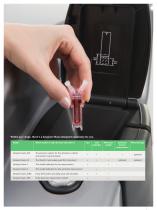
Within our range, there’s a Zetasizer Nano designed especially for you Model Which system is right for your laboratory? Zeta potential Molecular weight Advanced protein measurement The premium system for the ultimate in colloid and protein characterization The World’s most widely used DLS instrument The model dedicated to size measurement The model dedicated to zeta potential measurement Entry-level system providing value and versatility Entry-level size measurement system
Open the catalog to page 3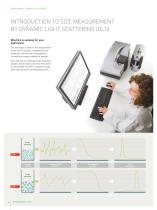
Performance, Simplicity, Versatility INTRODUCTION TO SIZE MEASUREMENT BY DYNAMIC LIGHT SCATTERING (DLS) The technique is ideal for the measurement of the size of colloids, nanoparticles and molecules, without requiring agitation to make the sample suitable for analysis. From the size, an estimate of the molecular weight can be made, which has the benefit of being faster to confirm oligomeric state than size exclusion chromatography (SEC). Scattered light
Open the catalog to page 4
Measuring molecular size by DLS To measure the diffusion speed, the speckle pattern produced by illuminating the particles with a laser is observed. The scattering intensity at a specic angle will uctuate with time, and this is detected using a sensitive avalanche photodiode detector (APD). The intensity changes are analysed with a digital autocorrelator which generates a correlation function. This curve can be analysed to give the size and the size distribution. NIBS: The ultimate optics for DLS measurement Research grade results with the ease of use of a routine system Patented NIBS...
Open the catalog to page 5
Performance, Simplicity, Versatility INTRODUCTION TO ZETA POTENTIAL AND PROTEIN CHARGE The importance of zeta potential and protein charge Electrical double layer How do you approach the development of a stable dispersion or assess product shelf life? Stern Layer Diffuse layer Do you run time consuming shelf tests? If so, there may be a better way to optimize sample stability and shelf life. The charge acquired by a particle or molecule in a given medium is its zeta potential and arises from the surface charge and the concentration and types of ions in the solution. Since particles of...
Open the catalog to page 6
Why measure zeta potential? The choices of materials used in a formulation may be restricted by regulations and also have an impact on cost. Knowledge of the zeta potential of particles in a formulation can be used to make logical choices about the chemistry of a formulation in order to select the most appropriate materials to provide stability and improve shelf life. Zeta potential can also be used to study the effect of formulation components on other bulk properties such as viscosity, in order to achieve lower viscosity at higher concentrations for example. Why measurement of protein...
Open the catalog to page 7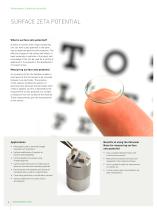
Performance, Simplicity, Versatility SURFACE ZETA POTENTIAL What is surface zeta potential? Surfaces in contact with a liquid containing ions can have a zeta potential in the same way as dispersed particles and molecules. This effective charge on the surface will attract or repel molecules or particles in the liquid, and knowledge of this can be used for a variety of applications, for example in the development of contact lenses. Measuring surface zeta potential An accessory cell for the Zetasizer enables a small piece of the at sample to be mounted between two electrodes. The presence of...
Open the catalog to page 8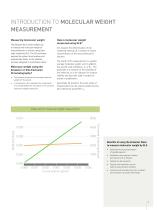
INTRODUCTION TO MOLECULAR WEIGHT MEASUREMENT Measuring molecular weight The Zetasizer Nano series enables you to measure the molecular weight of macromolecules in solution using Static Light Scattering (SLS). The SLS technique requires the system to be sensitive and exceptionally stable, so the Zetasizer has been designed to meet these criteria. Molecular weight using the Zetasizer or Size Exclusion Chromatography? • The Zetasizer measures the average molecular weight of the sample In comparison, SEC separates the components of a sample before the calculation of an accurate molecular weight...
Open the catalog to page 9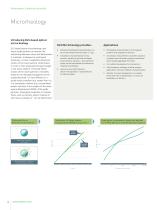
Performance, Simplicity, Versatility Microrheology Introducing DLS-based optical microrheology DLS-based optical microrheology uses tracer probe particles to measure the relationship between stress and deformation in materials. Analogous to mechanical rheometry, a stress is applied by Brownian motion of the tracer particle. Deformation or strain is then measured through changes in the tracer position. Thermally-driven motion of the tracer particle is intimately linked to the rheological properties of the suspending uid. It is very different in a purely viscous medium (e.g. water) than it is...
Open the catalog to page 10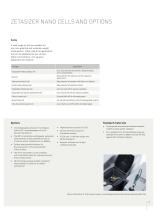
ZETASIZER NANO CELLS AND OPTIONS Cells A wide range of cells are available for size, zeta potential and molecular weight measurement. These extend the applications that can be addressed to low volumes, higher concentration, non-aqueous dispersants and solvents. Cell type Disposable folded capillary cell Size, zeta potential and protein charge avoiding cross contamination Zeta potential for aqueous and non-aqueous applications High concentration cell Zeta potential of samples with little or no dilution Surface zeta potential cell Zeta potential of material surfaces Disposable polystyrene...
Open the catalog to page 11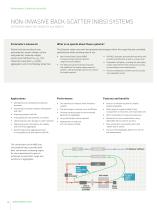
Performance, Simplicity, Versatility NON-INVASIVE BACK-SCATTER (NIBS) SYSTEMS ZETASIZER NANO ZSP, NANO ZS and NANO S Parameters measured What is so special about these systems? Particle and macromolecule size, zeta potential, protein charge, surface zeta potential, molecular weight, second virial coefcient A 2, B22, DLS interaction parameter kD, protein aggregation and microrheology properties. The Zetasizer series uses novel and patented technologies within the range that give unrivalled performance whilst retaining ease of use. • The diffusion barrier technique improves the stability of...
Open the catalog to page 12All Malvern Panalytical catalogs and technical brochures
-
MASTERSIZER_3000
13 Pages
-
CNA3 Copper
5 Pages
-
CNA3 Iron
5 Pages
-
CNA Cross-belt Analyzer
9 Pages
-
Water treatment solutions
8 Pages
-
Zetasizer Advanced
5 Pages
-
The Viscotek SEC-MALS 20
4 Pages
-
MicroCal PEAQ-DSC Automated
7 Pages
-
Mastersizer 3000E
11 Pages
-
Hydro SM
11 Pages
-
Mastersizer 3000 Chocosizer
2 Pages
-
Hydro EV
20 Pages
-
Hydro LV
20 Pages
-
Zetasizer Pro and Ultra
20 Pages
-
Aeris Cement Edition
8 Pages
-
2830 ZT
12 Pages
-
Axios Fast
8 Pages
-
CubiX3
4 Pages
-
X'Pert3 powder
12 Pages
-
Cement Solution
16 Pages
-
Insitec Dry
16 Pages
-
AERO M
2 Pages
-
VISCOTEK UV Detector
2 Pages
-
Viscotek UV-PDA Detector
2 Pages
-
NanoSight Range
12 Pages
-
MicroCal ITC Systems
16 Pages
-
Drug Development Solutions
20 Pages
























































